
What Happened in the USA?
In 2019, the US had scored the highest on the Global Health Security Index of Pandemic Preparedness. So how could a country that outranked 194 other countries suffer the third highest age-adjusted mortality among similarly ranked countries during the COVID pandemic? And why did the US also end up with the lowest vaccination rate among comparable countries? The answers are numerous and perhaps surprising.
“…this is really a crisis of competence. It’s not a crisis of science. It’s not a crisis of unwillingness to spend money. It’s not a crisis in the sense that, ‘Gosh, no one had ever heard of a pandemic danger.’ There were great movies and books about it, so people knew about the danger. They had science. They were willing to spend money. The failure was in knowing what to do and how to do it and then getting ready to do it.”
—Lessons from the COVID War: An Investigative Report 2023
Most glaringly, the US has a federated system of public health, meaning that each state determines its own approach to assuring its population’s health—resulting in over 3,000 public health departments in 53 states and territories. This disjointed health care system was not designed to work towards a common goal such as responding to the COVID crisis.
To make matters worse, after the 2008–2009 recession, spending cuts caused the loss of 55,000 public health positions. In spite of decades-old calls for increasing the number of medical professionals nationwide because of predicted shortages, the US health care system had instead functioned from shortage to shortage and found itself understaffed and overwhelmed by the sheer volume of patients and unrelenting professional fatigue of the existing staff. So, when the pandemic struck, the US public health system was fragmented and underfunded.
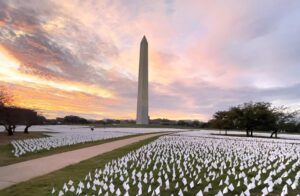
Nationally, the US public health system lacked a formally recognized lead person or organization. A majority of Americans believe this role belongs to the CDC; but the CDC is not structured to lead in a pandemic. Nor is it equipped to collect data on infections or to coordinate the response of discordant state governments or myriad dysfunctional public health systems.
Despite the great success of Operation Warp Speed, the US developed no plan for mass vaccination once vaccines were approved and in production.
The national stockpile of health supplies, moved to the states in anticipation of an H1N1 influenza outbreak in 2009, had not been replenished, even though President Obama had recommended it; Congress refused to allocate the money. And because the US had no national procurement process, states found themselves competing against each other for limited supplies like ventilators or personal protective equipment (PPE).
In 2020 the US had no national database for infection surveillance, and later on, it had none for circulating COVID variants of interest. But independent initiatives emerged to help out, such as the global data dashboard of COVID cases developed by the Center for Systems Science and Engineering and its Applied Physics Laboratory at John Hopkins University. Fortunately, the lab director Dr. Lauren Gardner and PhD student E. Dong immediately realized that without data we could not possibly begin to have the situational awareness needed to respond to this disease outbreak. This dashboard was up and running on January 20, 2020.
Unfortunately, the US also lacked any database of school closures, so schools in many places stayed closed far beyond what was necessary.
And approximately 43% of long-term care facilities had no emergency preparedness plans in place for an epidemic, even though such plans have long been required by Medicare.
Perhaps most shocking of all: despite the great success of Operation Warp Speed, the US developed no plan for mass vaccination once vaccines were approved and in production.
At the onset of the crisis the economic impact was immediate and severe: millions found their incomes suddenly depleted as businesses shut down and workers were laid off. The US economy lost 23 million jobs at the start of the pandemic and quickly entered recession. Caring for school-aged children, as well as assisting in their education, delivered additional stressors to parents struggling to remain in their jobs—if they still had jobs. Until the federal relief program went into effect, many families found it difficult or impossible to afford food and basic commodities, much less rent or mortgages.
All these difficulties were intensified by a stunning lack of leadership: despite long-standing and well-documented principles and instruments of public health communication, these important resources were ignored. The resulting lack of clear information on the virus’s virulence and modalities of spread created confusion around how to avoid infection exposure, created periods of lockdown and isolation longer than were probably required, and contributed to a general lack of confidence in government and authority—which later exacerbated and inflamed resistance to other recommendations for staying safe, such as the use of vaccines or wearing masks when ill.
And What Went Well?
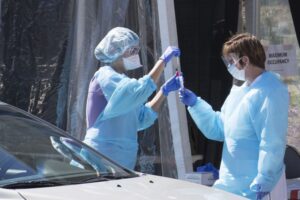
To be fair, government and the population demonstrated considerable resilience in surviving this prolonged crisis, including individual, institutional, local and state government initiatives. For example, state governors formed ad hoc buying consortiums to purchase personal protective equipment; handcrafters took up the call to make face masks for distribution; food pantry distributions sprung up in parking lots, and free school lunches were given to many children; Zoom allowed for both formal and informal communication to take place online (though children and parents struggled with online learning platforms, worsened in rural areas by slow or no internet, or lack of computers and/or computer skills); grocery stores offered online shopping opportunities; closed restaurants found their way to take and fulfill take-out orders; telehealth, online medical care for many medical issues, quickly emerged; in response to the crash in hotel occupancy, hotels made rooms available for the homeless; and voting by mail became more widely available.
Many hospitals, used to functioning as independent corporate entities, shared resources such as ventilators, staff, and information with one another and with the public.
Meanwhile, throughout the crisis, scientists and clinicians made new and rapid connections with their peers. Research was quickly shared among scientists nationally and globally, and best practices were exchanged across the country among clinicians desperate to find ways to treat those critically ill patients that were filling their beds. Many hospitals, used to functioning as independent corporate entities, shared resources such as ventilators, staff, and information with one another and with the public. And in January 2022, in an attempt to keep the surges down as the public became more active, the US government encouraged people to request free antigen tests, with 77 million households responding to this first offering. The CDC did not begin its wastewater surveillance of COVID-19 until September of 2022, but that program currently serves as an early warning system of COVID surges and continues to monitor outbreaks today.
External Stories and Videos
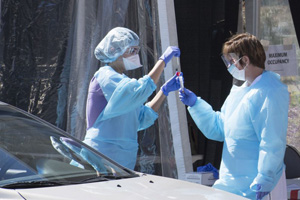
Has our dishonesty prolonged the pandemic and increased the spread of this deadly disease?
UPI
At the height of the COVID-19 pandemic, more than 40% of Americans were untruthful about whether they had the virus or were ignoring safety precautions.
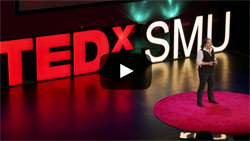
Watch: Coronavirus Is Our Future
Alanna Shaikh, TEDx
Global health expert Alanna Shaikh talks about the current status of the 2019 nCov coronavirus outbreak and what this can teach us about the epidemics yet to come.
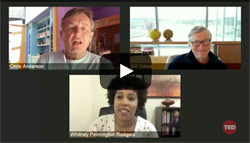
Watch: How We must Respond to the Coronavirus Pandemic
Bill Gates, Chris Anderson & Whitney Pennington Rogers, TED
Bill Gates offers insights into the COVID-19 pandemic, discussing why testing and self-isolation are essential, which medical advancements show promise and what it will take for the world to endure this crisis.
